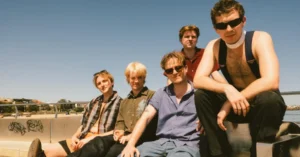8 Art Books to Read This Pride Month


“He taught me how to see, and how to trust what I saw. Painters have often taught writers how to see. And once you’ve had that experience, you see differently.” That’s writer James Baldwin reflecting in an 1984 interview on his late mentor Beauford Delaney, the queer Black painter who introduced the young writer to New York City and opened up for him a new way to see the world.
Their bond comprises just one thread in the interwoven artistic lineages we’re laying out this month, during a year in which a well-worn truism feels freshly urgent: The first Pride was a riot. For your June reading, we recommend art books that celebrate both this generational resistance and the freedoms queer and trans artists have always found in their work, from Nina Chanel Abney’s new catalog of butch portraiture and a biography of the late-19th-century lesbian photographer Alice Austen to an archive of the annual Fire Island invasion and a reissue of a slim book of David Wojnarowicz’s reflections and watercolor paintings. —Lakshmi Rivera Amin, Associate Editor
More Butch Heroes by Ria Brodell

In their introduction, Ria Brodell writes, “When I was a kid, the saints depicted on the holy cards were presented to me as role models or heroes.” More Butch Heroes presents the stories of several queer historical figures as portraits done in this style. The book, with a foreword by Chris E. Vargas, began as the author’s attempt to answer the question of what it would be like to be born a nonbinary or trans queer person in an earlier era, and to find people in history with whom they identified (in Brodell’s case, assigned female at birth, more masculine-presenting, and not heteronormative). In its final form, it is a new canon of heroes: people who did not conform to gender and sexual norms at a time when the language we have today didn’t exist, and in some cases, the risk of living their lives was great. Brodell centers figures like Joe Monahan, a 19th-century Idaho cowboy born “Johanna”; Kathleen M., a butch lesbian born around 1900 who lived with another woman and their adopted baby; Johnny Williams, a trans man born in Cape Town in 1930, and many others. Although the format is a beautiful tribute to the people, the most important element of More Butch Heroes is its reminder to gender-nonconforming people, burgeoning butches, and anyone who feels out of step with the “norm” that they’re not alone. —Natalie Haddad
Buy on Bookshop | MIT Press, April 2025
Memories That Smell Like Gasoline by David Wojnarowicz

When Amy Scholder was preparing the first edition of this book in 1992, David Wojnarowicz was dying in his East Village apartment, the one he moved into after the death of artist Peter Hujar — his lover, friend, and mentor. Years later, Ocean Vuong would come across a book by Wojnarowicz at a downtown Housing Works; he pens the introduction to this reissue by Nightboat, tracing one of many queer lineages into the present, during a “different yet not too changed socio-political hellscape,” as he puts it.
On top of essays by the above, Memories includes watercolors based on Wojnarowicz’s memories of porn theaters and other drawings, what Scholder calls a “diary of desire”: men getting head in the dark, slumped over railings, engaging in group sex. The four accompanying stories tell tales drawn from or inspired by his adolescence as a vagabond, to put it lightly. As you might imagine, this collection is sometimes upsetting: In one of the stories, the 15-year-old narrator recounts the violent assaults he suffered as a sex worker in New York. Disease is all over this book — STDs and cancers, but most pressingly, the ravages of the HIV/AIDS epidemic. The powerful last story tells of the experience of being emptied out by the virus: “I’m a xerox of my former self. I can’t abstract my own dying any longer.” But the writing is hypnotic, colloquial, and often surprising — the first story, for instance, ends with the obliterative brightness of a policeman’s flashlight, the prose dissolving into short line segments, too. —Lisa Yin Zhang
Pre-order on Bookshop | Nightboat Books, June 2025
Queer Happened Here: 100 Years of NYC’s Landmark LGBTQ+ Places by Marc Zinaman

Artist Paul Cadmus hung out at Minetta on MacDougal and Stewart’s on Seventh Avenue; Charles Demuth partied at Webster Hall in Greenwich Village; Peter Hujar, David Wojnarowicz, and Gordon Matta-Clark haunted the piers all the way on the west side — it’s almost unthinkable how much queer history happened in Manhattan, and a new book tries to map it. Queer Happened Here is a massive tome that serves as a great primer, whetting the appetite for more detailed inquiries. It includes a lovely foreword by drag artist Peppermint, who recounts how much of the city has been remade and how much it has forgotten: the Tunnel nightclub now an office building, Limelight a shopping center. Beginning in the wake of World War I and stretching all the way to clubs that opened in 2017, the book includes the names, addresses, and short summaries of each of these places. It also includes a trove of archival material that really emphasizes how rich this history is: ephemera such as playbills for performers at Club 82 on 4th Street; bookmarks printed by the Oscar Wilde Memorial Bookshop on Mercer; advertisements for bathhouses like the Everard Baths on 28th street; and a nightclub map of Harlem including Harry Hansberry’s Clam House, where the openly lesbian singer Gladys Bentley performed raunchy revisions. Author Marc Zinaman’s introductory essay is a personal take on growing up queer in New York, surrounded by history without knowing it, and feeling lonely as a result. This book will play some part in making that a rarer experience. —LZ
Buy on Bookshop | Prestel, May 2025
Speculative Light: The Arts of Beauford Delaney and James Baldwin, edited by Amy J. Elias

James Baldwin looms large in history; a trailblazing Black, queer author, he is a perpetual reference and inspiration for writers emerging in his wake. Lesser known is the man whom Baldwin credits with teaching him “how to see”: Beauford Delaney. An abstract painter and portraitist, Delaney imparted to Baldwin a painterly sensibility — an attention to and reverence for beauty in the minutiae of the world around him. Delaney introduced him to New York City’s downtown queer and Black life and its possibilities; Baldwin, in turn, introduced Delaney to Paris. Speculative Light is a collection of essays ruminating on their decades-long relationship, which transcended friendship and mentorship to resemble kinship — “chosen family.” Their intertwined stories, and their prolific oeuvres, are well-documented and ruminated on in essays by David Leeming, friend and biographer to both artists, and Robert G. O’Meally, who writes about the influence of jazz on their work and the “liquidity” of borders between genres and mediums. In his essay, Shawn Anthony Christian describes “Black artistic relation as a kind of genealogical transition.” Just as Baldwin and Delaney influenced one another, their influence has seeped into the artistic output of generations to come. Speculative Light invites us to learn, and to absorb, the incredible lessons of these queer Black artists. —Jasmine Weber
Buy on Bookshop | Read the Review | Duke University Press, February 2025
Too Good to Get Married: The Life and Photographs of Miss Alice Austen by Bonnie Yochelson

Standing on the edge of the Staten Island property where photographer Alice Austen lived for the vast majority of her life and looking out as gargantuan container ships and massive cruise ships make their way under the soaring metal span of the Verrazano Bridge, and into the protected waters of New York Harbor, you get some sense of the worlds that passed before her doorstep. You are also reminded of the relative isolation of her Staten Island, a place that, for much of Austen’s early life in the late 1800s, was an enclave for the wealthy. Her relatively bohemian home base allowed her to establish an unconventional life that provided the content for her riveting photographs of friends and lovers, offering a tantalizing and exceedingly rare visual record of one woman’s lesbian existence starting in the late 19th century. But Austen’s desire to remain mostly detached from the realities facing other New Yorkers at a time of enormous social and cultural upheaval makes her view highly specific. That said, Austen’s life and these images continue to have an impact, and this new, much more complete biography offers a better image of her than we’ve ever had before. —Alexis Clements
Buy on Bookshop | Fordham University Press, June 2025
Making A Way: Lesbians Out Front by JEB (Joan E. Biren)

Speaking of influential lesbian photographers, there are few who could be considered as influential as Joan E. Biren, not just because of her foundational body of work but also the ways in which she disseminated it and, in the process, opened up the field of photography to countless people along the way. Her first book, Eye to Eye: Portraits of Lesbians, originally published in 1979 and reissued in 2021, gave a sense of JEB’s loving and open gaze. Now, in the reissue of her second book, Making A Way: Lesbians Out Front, first published in 1987, we not only get even more photos than in the first, as well as extended commentary and perspective from the subjects of her photos, but a chance to understand that to make a book like this JEB had to know, care for, and build relationships with everyone she photographed. From Audre Lorde working on the final draft of Zami (1982) to drag artist Stormé DeLarverié laughing outside the Cubby Hole and activist Urvashi Vaid walking the picket line, to lesbians whose names you’ve likely never heard before engaging in their work, their lives, and their activism, these images may serve a different role today than in the 1980s, but they are no less powerful and needed. —AC
Pre-order on Bookshop | Anthology Editions, July 2025
Nina Chanel Abney: Big Butch Energy/Synergy, edited by Alex Gartenfeld

It’s no secret that many queer women, as well as individuals charting their trans journeys, reckon with the legacy of butch sensibility. Deciding how butch or femme they wish to present can drive an intense internal monologue, and the art world has not done enough to center visual art that might empower people to better navigate this dichotomy. Artist Nina Chanel Abney fills the void with a beautiful new catalog, Big Butch Energy, which accompanied recent shows at the Institute of Contemporary Art Miami and the Museum of Contemporary Art Cleveland. When she first began showing these portrayals of butches of color, Abney was surprised by how many viewers mistook her subjects for cisgender men. For those who aspire to be allies, Abney’s work offers a way to become more familiar with the nuances of butch sensibility. For butches, this is a rare moment to see the breadth of their aesthetics celebrated and cherished. —Daniel Larkin
Buy on Bookshop | Delmonico Books, May 2025
Fire Island Invasion: Day of Independence by Anderson Zaca

Drag queens invade Fire Island, a storied haven of queer and trans community, every Fourth of July weekend. This tradition began in 1976 after a local restaurant ignominiously denied service to Panzi, or Thom Hansen, who happened to be dressed to the nines. Panzi lived his life in women’s clothes, long before today’s definitions would evolve to offer an opportunity to self-identify on the trans spectrum. A decision was then made for an entire group of drag queens to visit Fire Island to prove a point. The spectacle was so well-received that it became an annual tradition. The invasion cemented a paradigm shift of no longer capitulating to straight homophobes and closeted trans and queer people on Fire Island, who soon left or came out publicly. What has been missing for some time is a comprehensive art book that documents this annual festival. Photographer Anderson Zaca fills this gap with his new book. Zaca, who began photographing the invasion in 2007, has honed his approach to juxtapose the art of drag with the island’s beachy environs. Whereas most photos of drag queens are staged in dark spaces at night, Zaca excels at the challenge of portraying these artists in full sunlight and accentuating the spectacular ironies of drag on the seashore. —DL
Buy on Bookshop | Damiani Books, May 2025
New Monographs & Catalogs
- Arshile Gorky: New York City (Hauser & Wirth Publishers, June)
- David Hockney (W. W. Norton, June)
- Hilma af Klint: What Stands Behind the Flowers (Museum of Modern Art, May)
- Revisions: Francis Bacon in the Act of Painting (W. W. Norton, May)
- Tacita Dean (MIT Press, May)





